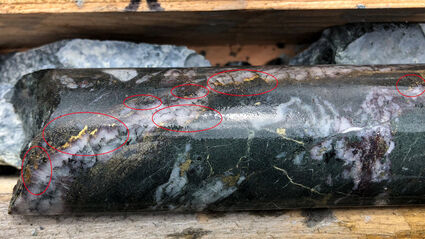Aben extends Forrest Kerr drilling
North of 60 Mining News – August 23, 2019
Last updated 9/26/2020 at 5:27am

Aben Resources Ltd.
The visible gold in this core is from FK 10-18, a 2018 hole that cut one meter of 331 g/t (9.65 oz/t) gold in the North Boundary zone at Forrest Kerr.
Aben Resources Ltd. Aug. 20 provided updates on an expanded drill program at its Forrest Kerr gold project in British Columbia's Golden Triangle and Justin gold project in southeastern Yukon.
At Forrest Kerr, Aben is encouraged by initial results from a more than 5,000-meter initial phase of drilling and has budgeted additional funds to extend the drilling into fall.
"We are off to a great start for the 2019 drill season," said Aben Resources President and CEO Jim Pettit. "We have some exciting theories to test from the analysis of the last few years drill results as well as our new geophysical survey results."
So far, drilling at Forrest Kerr is focused on the North Boundary zone and peripheral areas were previous drilling has encountered high-grade gold.
One hole drilled by Aben last year, FK18-10, cut 10 meters of 38.7 grams per metric ton (1.12 ounces per metric ton) gold from a depth of 114 meters, including one meter of 331 g/t (9.65 oz/t) gold.
This is very similar to the one meter of 326 g/t gold Noranda encountered in RG91-16, a historical hole drilled roughly 200 meters to the south.
FK19-46, a hole drilled this year to test for continuity of this high-grade gold mineralization, encountered multiple mineralized horizons. The entire 500.5-meter length of this hole averaged 0.12 g/t gold, including a one-meter section of 12.4 g/t gold starting at 203 meters.
Another hole, FK19-50, tested the downward extension of a mineralized horizon discovered in holes FK18-17 and FK18-18 drilled last year.
FK18-17 cut 15 meters of 3.18 g/t gold from 232 meters and one meter of 31.4 g/t gold from 261 meters; and FK18-18 cut four meters of four g/t gold from 233 meters.
FK19-50 cut 61.7 meters of 0.46 g/t gold. Aben said this longer section includes intermittent higher-grade gold intercepts within broad lower grade envelopes associated with fractures and fault structures.
Aben said the mineralized structures correlate very well with magnetic highs that were delineated by an airborne survey flown in May. Thus far, drilling in this part of the Forrest Kerr Property has only tested a small portion of the potentially mineralized structures defined by the magnetic survey.
FK19-51 drilled roughly 500 meters south of the main mineralized core at North Boundary, cut sporadic gold-silver-copper-zinc-lead within strong alteration.
Gold mineralization in this hole was generally low grade and not as strongly correlated to the repetitive sequences of copper mineralization.
Hole FK19-52 was drilled from the same set-up at a steeper angle – assay results pending.
"As we work our way south of the mineralized core of the North Boundary zone, we are looking for potential connectivity with the historic, high-grade gold discovery made by Noranda in 1991," said Pettit. "As noted from the description of Hole FK19-51, we have been drilling a highly altered zone of mineralization a few hundred meters south of the Noranda hole. The style of alteration and mineralization in this zone has a strong association with elevated gold values in the region as well as a strong copper mineralization represented by chalcopyrite. The mineralization in this type of setting is definitely something we want to chase."
Justin results are in
In addition to initial results from Forrest Kerr, Aben reported results from its early season drill program at the Justin gold property in the Yukon.
A diamond drill rig completed 963 meters of drilling in four holes at POW, a zone that contains gold-bearing vein, breccia and skarn replacement mineralization.
Discovery drilling carried out at POW in 2011 and 2012 cut wide zones of lower grade intrusion-related gold mineralization. Highlights from this drilling include 60 meters of 1.19 g/t gold and 46.4 meters of 1.49 g/t gold.
Two holes drilled this year, JN19020 and JN19021 stepped out roughly 125 meters from the previous drilling.
JN19020 cut 15.4 meters of 1.5 g/t gold; and JN19021 cut 3.3 meters of 0.9 g/t gold.
A rotary air blast hole (RAB), JN19042, targeted near-surface pyrite-arsenopyrite veins observed in hole JN19021. The RAB hole cut 1.5 meters of 0.2 g/t gold. Sampling was hindered by extremely wet hole conditions, which may reduce the reliability of analytical results.
JN19031, which tested a magnetic anomaly at POW Zone did not return significant results and the source of this anomaly remains unclear.
JN19039 cut 9.5 meter of 0.2 g/t gold in the Justin fault at POW.
Rotary air blast drilling at the Lost Ace Zone was successful in intersecting the contact of rock units where visible gold was discovered in surface sampling during 2018.
JN19026 cut 1.5 meters of 0.9 g/t gold and JN19029 cut three meters of 0.5 g/t gold.
–SHANE LASLEY












Reader Comments(0)